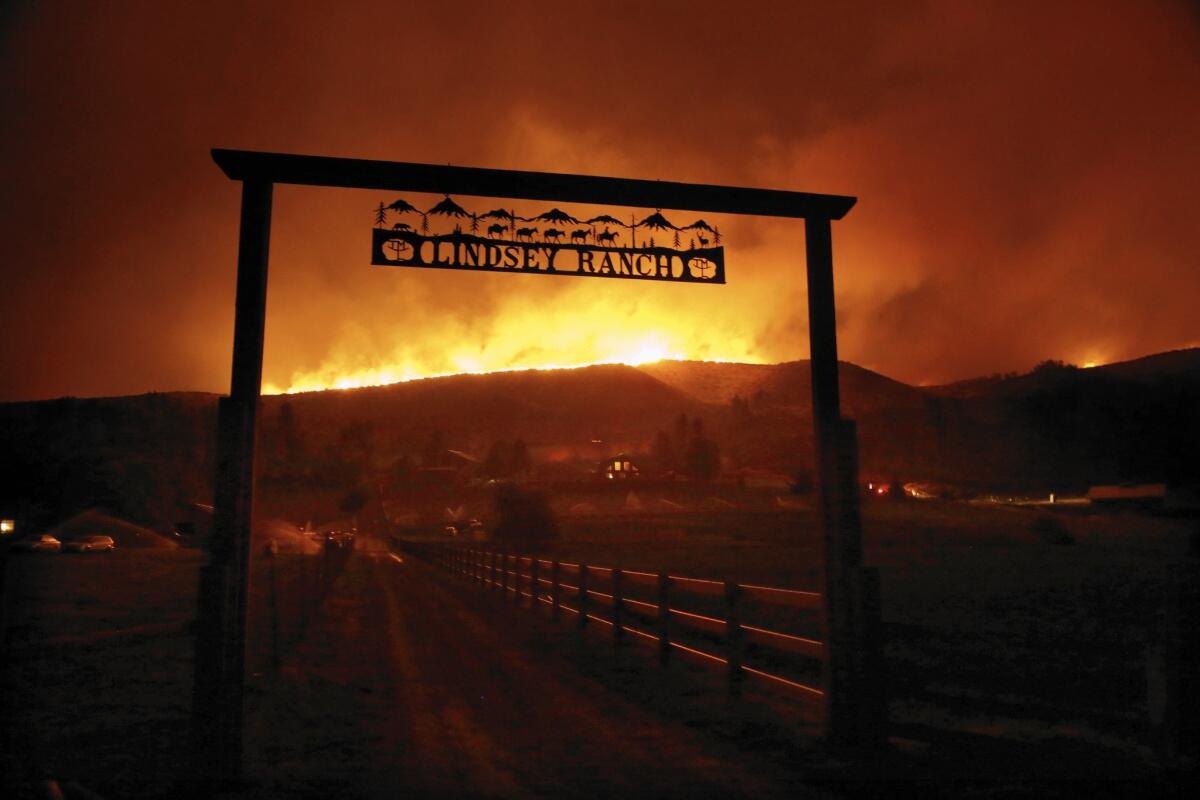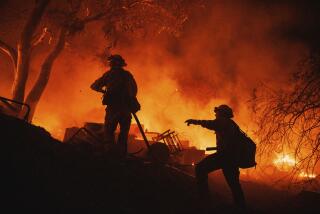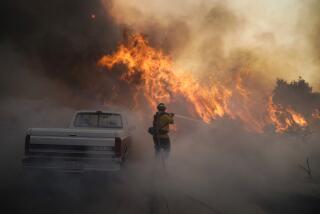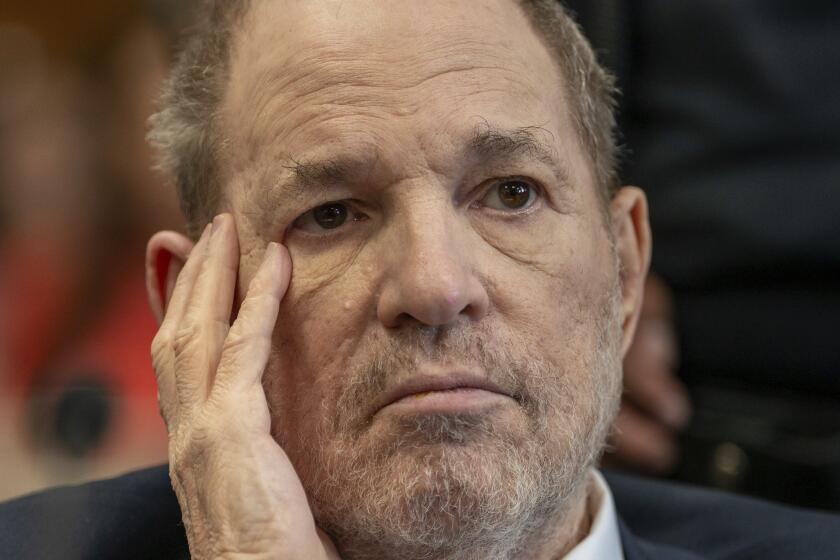Washington state residents and officials are worried about fires and money to fight them

Fire burns on the ridge above a ranch in Twisp, Wash., on Wednesday. Three U.S. Forest Service firefighters died battling the blaze.
The wildfire season started slowly.
Then, just a few weeks ago, a series of lightning strikes here in arid eastern Washington combined with unusually high winds — and everything changed.
More than 400,000 acres had burned by Friday, thousands of residents and tourists had been evacuated, scores of homes had been destroyed and three federal firefighters had died battling the blazes.
“It happened in just a matter of a couple of weeks,” said Tina Boehle of the National Interagency Fire Center. “We’ve had to put resources quickly in so many areas.”
The rapid surge has so thinly stretched the traditional blend of federal, state and local firefighters who work together each year that, for the first time since 2006, the Defense Department plans to quickly train and deploy more than 200 soldiers to join the fight as soon as this weekend. Some states, including Oregon, are enlisting the National Guard.
Washington is burning like rarely before. At least 15 fires were burning across the state. Nearly a dozen counties and four Indian tribes have been affected, and at least 100 homes and structures have been destroyed.
Gov. Jay Inslee, noting that last year’s fire season was devastating as well, said Thursday that the fires of 2015 were “an unprecedented cataclysm in our state.”
Still, he and other officials tried to assure weary, frustrated and displaced residents that more help was on the way. He noted that 3,000 firefighters and emergency personnel are helping the fight — people “who are doing everything they can to make sure the Evergreen State does not become an everfire state.”
Yet with conditions not expected to improve soon, the stress on resources has angered some residents.
“Don’t even get me started,” said Tracy Price, who fled her house in the town of Pateros early Thursday and whose sister-in-law lives near a fire burning in the nearby town of Tonasket. “They have no air support. They have nothing.”
Last year, Price lost many of her most personal effects, things like photos that could never be replaced, when the massive Carlton Complex fire burned an outbuilding on her property. The fire also destroyed her mother’s home of four decades.
Fires this year threaten her house as well as those of her in-laws and daughter, Price said.
With climate change expected to make the West increasingly hot and dry, some point to broader debates, including over how the federal government pays for fighting wildfires — or, as some critics say, how it does not pay.
Even with many weeks remaining in the wildfire season, the U.S. Forest Service expects to exhaust its firefighting budget by early next month. Once again, the agency will pay for firefighting by resorting to “fire borrowing” or “fire transfers”: taking money from other Forest Service programs, including some that thin forests to make them more resilient against large fires.
The Forest Service said in a recent report that, nationwide, six of the worst fire seasons since 1960 had occurred since 2000. This year, the agency announced that for the first time it would spend more than half its budget fighting wildfires.
Several members of Congress on both sides of the aisle are pushing solutions, with growing support for the idea that the agency’s budget should not constantly be at the mercy of wildfires.
“The current system of paying for wildfires by perpetually taking funding away from the programs that enable the agency to maintain recreation facilities and complete important restoration projects is simply unacceptable,” Sen. Maria Cantwell, a Democrat from Washington, who has proposed legislation to change how firefighting is funded, wrote this month. “We can’t sit idle and expect this budget issue to fix itself.”
Residents here emphasized their support for firefighters and emergency workers, some of whom have come from as far away as Michigan.
The three firefighters who died were employees of the Forest Service based in the area and had been deployed to a fire near Twisp, about 150 miles northeast of Seattle, on the eastern, more arid side of the Cascade Mountains. They were identified as Andrew Zajac, 26, of Winthrop; Richard Wheeler, 31; and Tom Zbyszewski, 20, a junior physics major at Whitman College in Walla Walla.
The firefighters “were engaged in initial attack operations and were involved in a vehicle accident when it is believed that the fire overtook the vehicle,” according to an account by Okanogan County Sheriff Frank Rogers that was provided by the Forest Service and the Washington Department of Natural Resources.
Of the four injured, one was employed by the Forest Service, two worked for the Department of Natural Resources and one was a contractor with the department.
One of the injured, Daniel Lyon, 25, of Puyallup, Wash., was in critical condition at Harborview Medical Center in Seattle, hospital officials said Thursday morning. He was in intensive care with burns to about 60% of his body. The hospital said the public was welcome to send the firefighter notes of encouragement.
Two of the injured have been treated and released, according to the Forest Service. The status of the fourth firefighter was unclear.
Erik Knapp, delivering bundles of the Wenatchee World newspaper Thursday morning, said he was grateful — his home had been saved so far — but also worried as fire threatened the region yet again, whipped by high winds. Like others, he said, he would feel better if firefighting resources were not so scarce.
Recalling the electrical storms in the area last week, he said, “There were so many lightning strikes and so little manpower. It got out of control.”
But he added, “Overall, I’d say the firefighters did an excellent job. As I delivered papers through the fire area, there was fire next to a lot of the homes, but a lot were saved.”
Tom Tidwell, chief of the Forest Service, joined Inslee, Cantwell, Sen. Patty Murray (D-Wash.) and other state officials in Chelan on Thursday. All emphasized their sympathy for the families of the firefighters who died, as well as the four who were injured. Tidwell deflected questions about agency policy and funding.
“Yes, this year we anticipate we’ll be running through our appropriated funds probably in early September and then we’ll be transferring other funds,” Tidwell said during a news conference at a Chelan County fire station. “But that does not have any effect on the job that we’re doing out here to work with our partners to be able to suppress these fires.”
maria.laganga@latimes.com; Twitter: @marialaganga
william.yardley@latimes.com; Twitter: @yardleyLAT
ALSO:
Growing Washington wildfires are ‘an unprecedented cataclysm,’ governor says
When a Washington fire chief called for help, no one was left
3 firefighters killed, 4 hurt battling one of Washington state’s many wildfires
More to Read
Start your day right
Sign up for Essential California for news, features and recommendations from the L.A. Times and beyond in your inbox six days a week.
You may occasionally receive promotional content from the Los Angeles Times.








